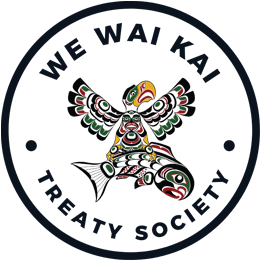Stage 1: Statement Filed
Statement of Intent In 1993, our treaty group filed a Statement of Intent to negotiate a treaty. The British Columbia Treaty Commission (BCTC) accepted the Statement of Intent as complete and forwarded it to the federal and provincial governments.
Stage 2: Preparation for Negotiations
After receiving our Statement of Intent, the Commission called an initial meeting of the three parties (Federal and Provincial Governments and our representatives). In this meeting we exchanged information, discussed research required to prepare for negotiations and generally identified the issues of concern.
We also:
• Appointed a negotiator
• Confirmed negotiators mandate
• Identified our financial resources to carry out negotiations
• Adopted a ratification procedure
• Identified what we intended to negotiate
• We also identified areas of overlapping territory with other
First Nations
The Canadian and British Columbia Governments obtained background information on the communities, people and interests likely to be affected by our negotiations and established mechanisms for consultation with non-aboriginal interests. BCTC confirmed that we were ready to begin negotiating a Framework Agreement.
Stage 3: Negotiation of a Framework Agreement
The Framework Agreement is, I effect , the “table of contents” for a treaty negotiation. It is a negotiated agenda that identifies the issues to be negotiated, the goals of the negotiation process, any special procedural arrangements and a timetable for negotiations. It may also identify milestones that should be reached at specified stages in the process.
Stage 4: Negotiation of an Agreement in Principle (AIP)
This is the stage where negotiations really begin and this is the stage where we are at today. The goal of Stage 4 is to reach major agreements that will form the basis of treaty. During this stage, we will be examining the elements of the Framework Agreement in detail. Rights and Obligations, including existing and future interests in land, sea and resources structures and authorities, regulatory processes dispute resolutions and fiscal arrangements will be identified. The Agreement in Principle will confirm the ratification process, conclude mandates and lay the groundwork for an implementation plan. The ratification process allows the parties to review the emerging agreement with their membership and either approve, reject or seek amendments to it. British Columbia has announced that Agreements in Principle will be subject to public review before ratification.
Stage 5: Negotiation to Finalize a Treaty
Once the Agreement in Principle has been approved by the membership. The treaty will formalize the new relationship among the parties and embody the agreements reached in the Agreement in Principle. Technical and legal issues will be resolved at this stage, but, issues already settled will not be re-opened. The treaty will be signed and formally ratified at the conclusion of this stage.
In 2019 we signed the Tripartite Commitment Agreement: We Wai Kai Transition to Stage 5 Negotiations Under the BC Treaty Process, this was not the traditional Agreement in Principal, essentially we signed a Memorandum of Understanding. This fast tracked us into the 5th stage of the treaty negotiations.
Click here to view the document:
Stage 6: Implementation of the Treaty
Long term implementation plans will be tailored to specific agreements.
To learn more about the BC Treaty process, please visit the BC Treaty link: Negotiation Processes
